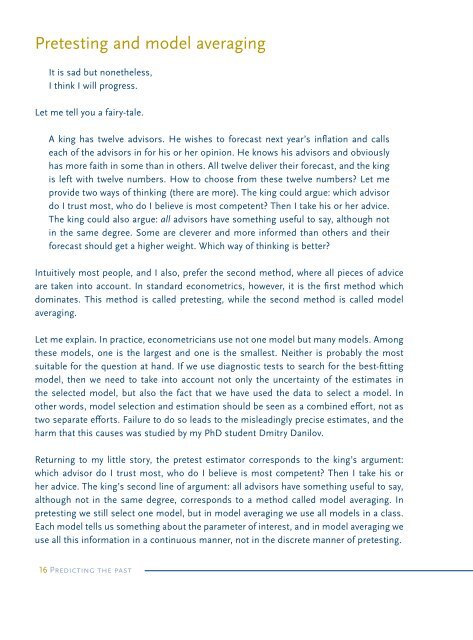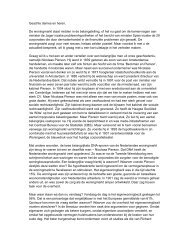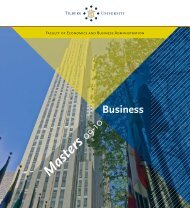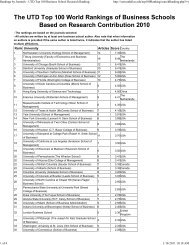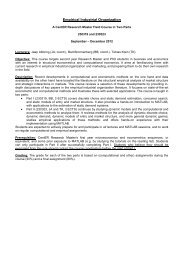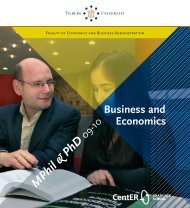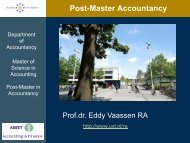Predicting the past - Tilburg University, The Netherlands
Predicting the past - Tilburg University, The Netherlands
Predicting the past - Tilburg University, The Netherlands
Create successful ePaper yourself
Turn your PDF publications into a flip-book with our unique Google optimized e-Paper software.
Pretesting and model averaging<br />
It is sad but none<strong>the</strong>less,<br />
I think I will progress.<br />
Let me tell you a fairy-tale.<br />
A king has twelve advisors. He wishes to forecast next year’s inflation and calls<br />
each of <strong>the</strong> advisors in for his or her opinion. He knows his advisors and obviously<br />
has more faith in some than in o<strong>the</strong>rs. All twelve deliver <strong>the</strong>ir forecast, and <strong>the</strong> king<br />
is left with twelve numbers. How to choose from <strong>the</strong>se twelve numbers? Let me<br />
provide two ways of thinking (<strong>the</strong>re are more). <strong>The</strong> king could argue: which advisor<br />
do I trust most, who do I believe is most competent? <strong>The</strong>n I take his or her advice.<br />
<strong>The</strong> king could also argue: all advisors have something useful to say, although not<br />
in <strong>the</strong> same degree. Some are cleverer and more informed than o<strong>the</strong>rs and <strong>the</strong>ir<br />
forecast should get a higher weight. Which way of thinking is better?<br />
Intuitively most people, and I also, prefer <strong>the</strong> second method, where all pieces of advice<br />
are taken into account. In standard econometrics, however, it is <strong>the</strong> first method which<br />
dominates. This method is called pretesting, while <strong>the</strong> second method is called model<br />
averaging.<br />
Let me explain. In practice, econometricians use not one model but many models. Among<br />
<strong>the</strong>se models, one is <strong>the</strong> largest and one is <strong>the</strong> smallest. Nei<strong>the</strong>r is probably <strong>the</strong> most<br />
suitable for <strong>the</strong> question at hand. If we use diagnostic tests to search for <strong>the</strong> best-fitting<br />
model, <strong>the</strong>n we need to take into account not only <strong>the</strong> uncertainty of <strong>the</strong> estimates in<br />
<strong>the</strong> selected model, but also <strong>the</strong> fact that we have used <strong>the</strong> data to select a model. In<br />
o<strong>the</strong>r words, model selection and estimation should be seen as a combined effort, not as<br />
two separate efforts. Failure to do so leads to <strong>the</strong> misleadingly precise estimates, and <strong>the</strong><br />
harm that this causes was studied by my PhD student Dmitry Danilov.<br />
Returning to my little story, <strong>the</strong> pretest estimator corresponds to <strong>the</strong> king’s argument:<br />
which advisor do I trust most, who do I believe is most competent? <strong>The</strong>n I take his or<br />
her advice. <strong>The</strong> king’s second line of argument: all advisors have something useful to say,<br />
although not in <strong>the</strong> same degree, corresponds to a method called model averaging. In<br />
pretesting we still select one model, but in model averaging we use all models in a class.<br />
Each model tells us something about <strong>the</strong> parameter of interest, and in model averaging we<br />
use all this information in a continuous manner, not in <strong>the</strong> discrete manner of pretesting.<br />
16 <strong>Predicting</strong> <strong>the</strong> <strong>past</strong>


